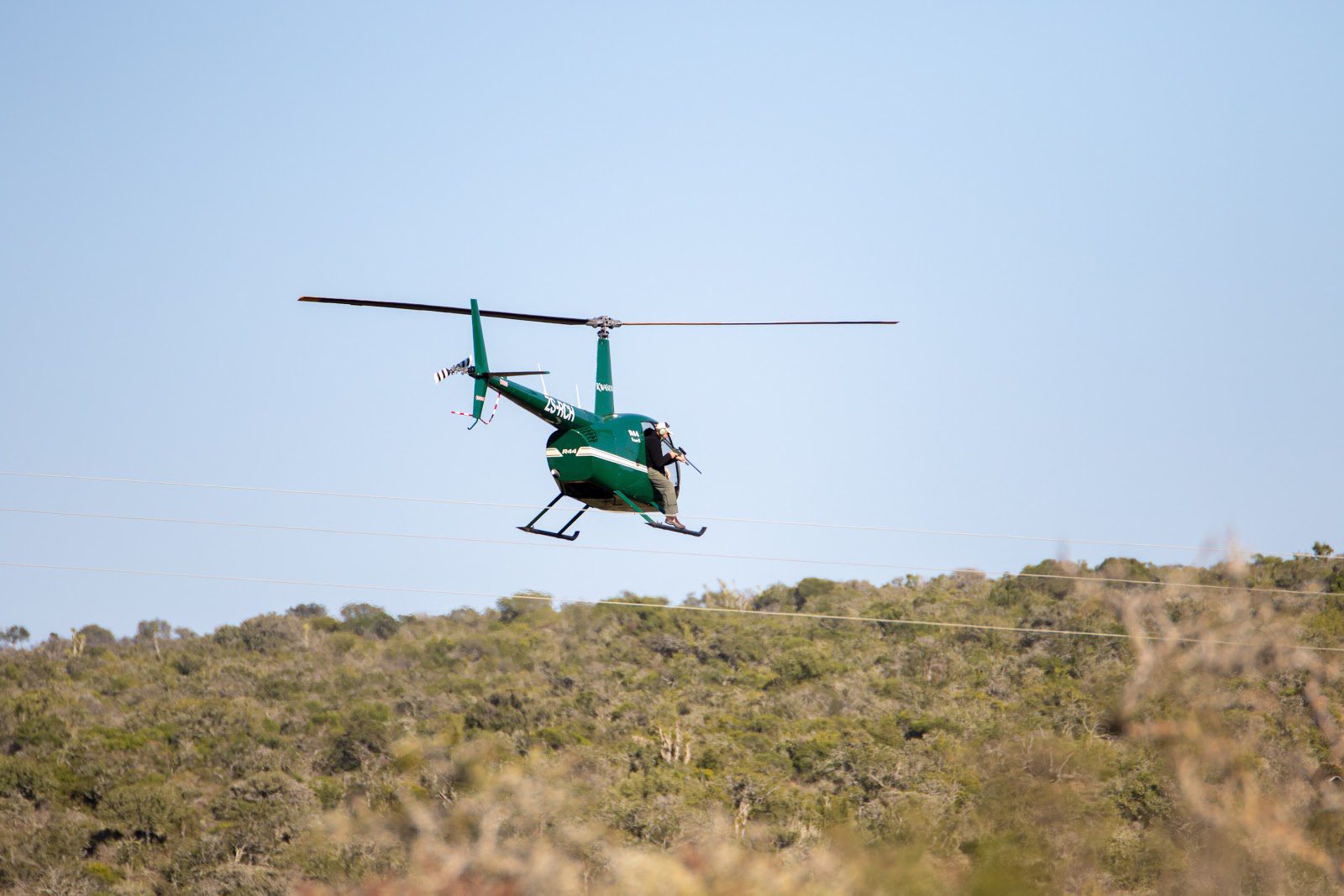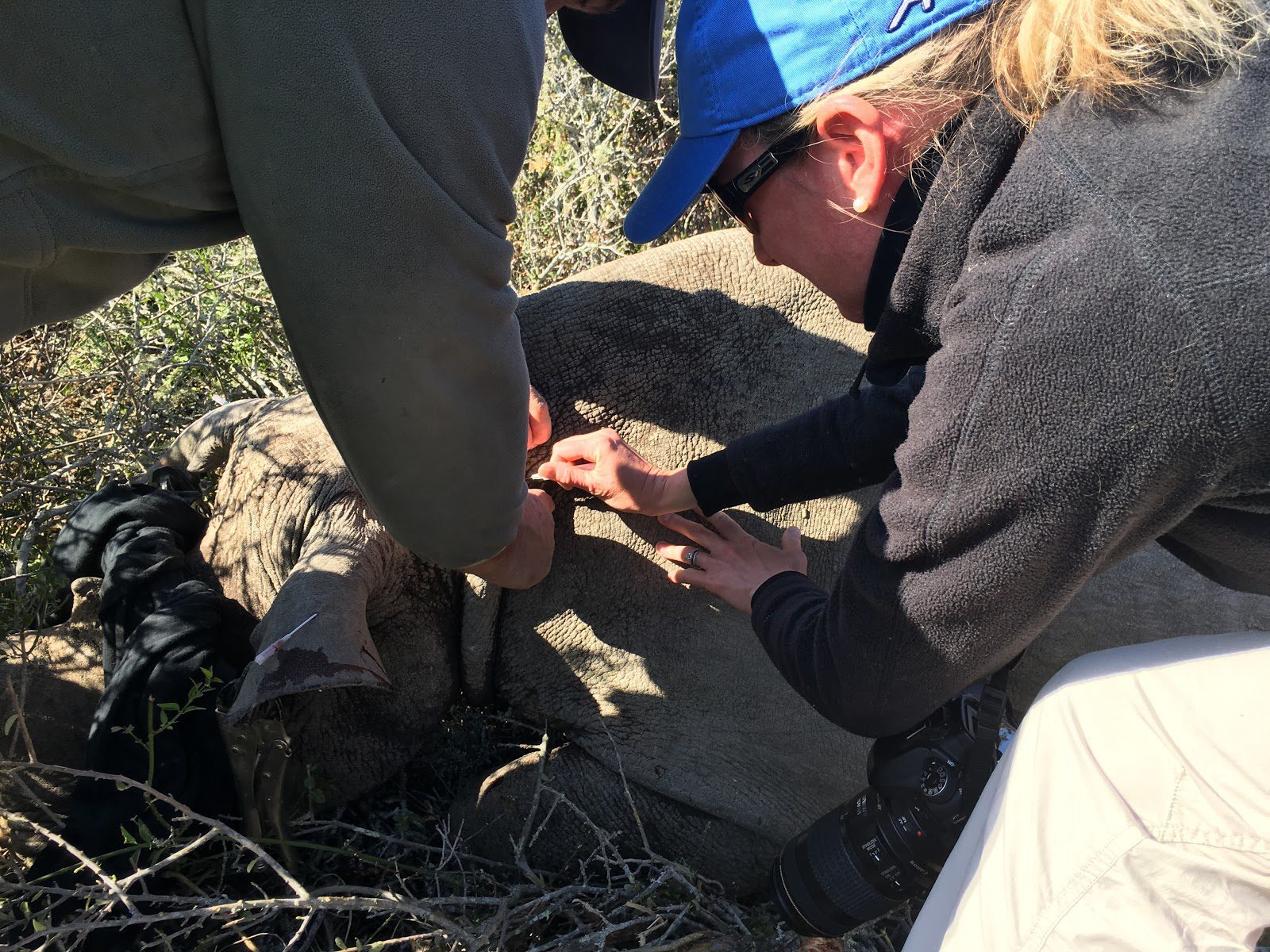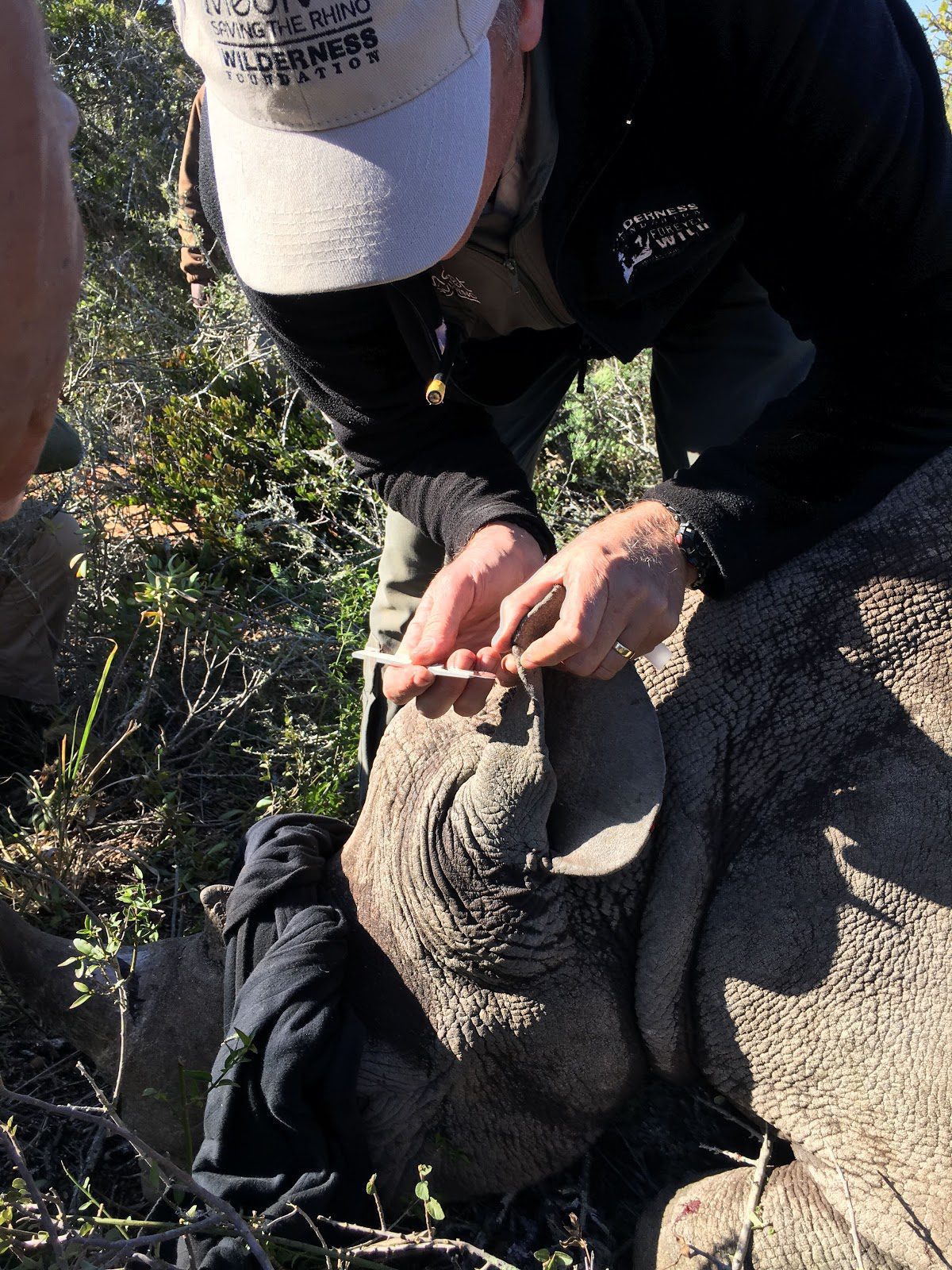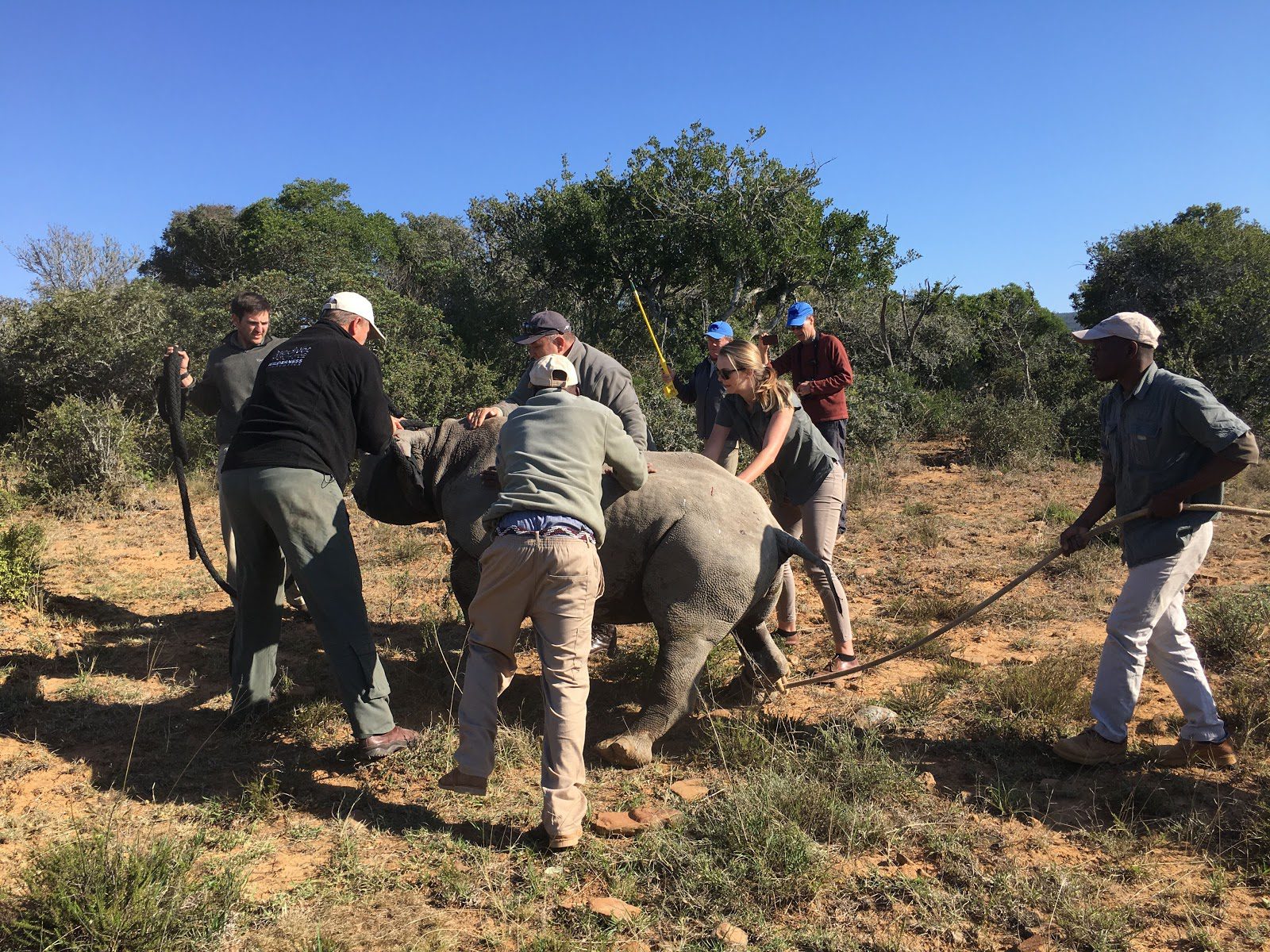
Why Do Rhinos Need to Be Darted?
Rhino darting is an integral component to conservation and wildlife protection on the reserve.
When Kwandwe darts animals, it’s to tag them for future monitoring. The better they’re able to keep track of endangered animals like rhinos, the better chance they have of preventing poaching.
While I was staying at Kwandwe, a 54,000-acre expanse of wilderness in South Africa’s Eastern Cape, one of the reserve’s calves was getting ready to leave its mother. Because it was going to be on its own, the conservation team needed to be able to tag it and keep track of it separately.
How Does the Rhino Darting Process Work?
First the reserve sent a team, including a veterinarian, via helicopter to locate the mother/calf duo. Once the rhinos had been found, they radioed our guide for us to drive in separately.

The darting itself happened before we arrived to make it as stress-free as possible for the mother and calf. (More cars, noise, and people aren’t exactly calming, are they?) That day, we were working with black rhinos, which tend to be a little more skittish and difficult than white rhinos.
We drove through thick, scrubby brush, the hills dotted with low, fat trees. It can be hard to spot the open spaces between the brush—or navigate at all, whether on foot or by car.
When we arrived, the team was moving tree branches and foliage around to clear extra space for when the rhinos would later awake.
We watched them blindfold the duo, then separate them so the team could work on tagging the calf at a distance. All the while, Kwandwe’s team constantly monitored anesthetic levels for both rhinos.
Once separated, it was the guests’ turn to join in.
Kwandwe’s vet team directed each of us as to how we could be of most use. We were invited to do some very hands-on work!
Before I knew it, I was helping Kwandwe’s general manager, Angus, to implant a microchip in the calf—and feeling very intimidated at first!

We had to find a soft, fatty area of skin that the large microchip needle could get through—the skin around the neck is perfect for this.
“You’re going to have to push really hard to get the chip in as far as we need it,” Angus reminded me calmly.
But was I going to hurt it? What if I did it wrong?
Remember, I told myself, They wouldn’t let you do anything you might mess up.
With that, I plunged the needle in. Once it broke the outer skin, it was smooth and quick, just like any old shot. I pulled the needle back out, feeling like a part of the team.
Angus smiled and directed me to help some of the others, giving shots, taking blood, and marveling at these incredible animals right before our eyes.

The team clipped and notched the rhinos’ ears. This would allow Kwandwe’s team to identify the rhinos while out on future game drives and aid their efforts to monitor the animals’ behavior and development over time.
When it was time for the baby to wake, we watched it slowly regain its senses as the anesthetic wore off, and the Kwandwe team guided it back to its mother.
Usually, in cases like this, the two will hunker down in some shade and sleep off any residual grogginess. Other guides will check in on them throughout the day.
We left them in privacy as the mother rhino began to wake, feeling grateful and humbled to have participated in protecting this amazing pair of animals.
Rhinos at Kwandwe Private Game Reserve ©Extraordinary Journeys
What I Learned from My Rhino Monitoring Experience
My rhino monitoring experience lasted only a few hours, but it left an indelible mark on me. I still feel the same kind of awe I felt that day, even months later.
Seeing rhinos up-close—and understanding just how vulnerable these massive creatures really are—is a profoundly moving experience.
Despite everyone’s best efforts, you run the risk of hurting the very wildlife you’re trying to help.
At the same time, you’re faced with the knowledge of the constant threat of poachers. These incredibly strong, healthy rhinos are in immense danger, and they need our help.
It takes an enormous amount of social support and financial resources to adequately protect these animals.
Everybody says it, but it really is up to all of us to truly care and act on our convictions—whether that’s rhinos or other endangered wildlife. Conservation needs to be an “all-in” endeavor.
Being part of Kwandwe’s rhino monitoring was such a gift. When you participate in these same efforts, you’ll walk away knowing you’ve truly made a difference.
RELATED: Why Wildlife Needs Community Involvement
How Does a Rhino Excursion Fit Into My Safari?
Typically, a rhino monitoring excursion like mine will take a full morning or afternoon and will replace one of your daily game drives.
Plan on being out between three to five hours, depending on the unique situation of your outing.
EJ travelers privately book this experience, so it’s exclusive to you and your personal travel companions.
May through the end of September is the ideal timeframe for this special rhino activity because the weather’s cooler, but it can usually be arranged year-round.
RELATED: Custom Travel: 4 Trends We Love
Why Do You Recommend Kwandwe’s Rhino Monitoring Program?
We have a couple of favorite lodges and reserves we trust with rhino monitoring programs, and Kwandwe is one of them.
For one, the team behind Kwandwe’s conservation management makes sure the animals are darted only when absolutely necessary. This special activity is only an option when it aligns with Kwandwe’s conservation efforts and makes sense for the wildlife, not whenever travelers request it.
As such, you may not get to participate during your stay. But you can be assured Kwandwe’s priorities are in order—it’s about conservation, not raking in the tourism revenue.

How Much Does a Rhino Conservation Safari Like Jenny’s Cost?
The rhino darting and notching experience at Kwandwe costs $4,000. This flat-rate fee applies to a group of up to eight participants. Every dollar goes directly to conservation. Other companies may claim to help wildlife, but it’s often lip-service.
In fact, the operations that offer the chance to pet a baby lion, for instance, fly in the face of conservation. These are commercial enterprises that often sell the animals to hunters (for more on the subject, we recommend you view Blood Lions).
We can’t recommend programs like Kwandwe’s highly enough. They have the best interests of the animals in mind at all times, above all else. We’re proud to partner with them.
Where Else Can I Participate in Rhino Conservation?
- Tswalu Kalahari in South Africa
- Phinda Private Game Reserve in South Africa
- Tuningi, part of Madikwe Game Reserve in South Africa
- Lewa Wildlife Conservancy in Kenya
- Saruni Rhino, part of Sera Conservancy in Kenya
Why Would a Rhino Monitoring Experience be Right for Me?
- You care about wildlife
- You aren’t afraid to get your hands dirty
- You want to leave your destination better than you found it
- You’d like to make a financial contribution in support of reputable conservation efforts
- You’re looking for an uncommon, exclusive addition to your safari experience
Please note: this experience is limited to travelers age 16 and older.
RELATED: This is Why You Need to Fly Camp on Your Safari
When to Go
The best time to include a rhino monitoring experience in your safari is May through September. We recommend you stay for three nights and four days to make the most of your experience. (Please note: the above mentioned price for this conservation experience excludes accommodation.)
Plan Your Visit
Ready to start planning your dream rhino monitoring safari? We make the process stress-free and enjoyable. Call or email us today to begin crafting your customized experience today!
Then, start packing that suitcase because we’ve got all the details covered.
